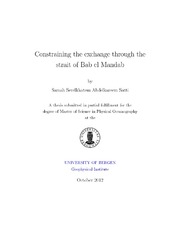| dc.contributor.author | Satti, Samah Serelkhatem Abdelkareem | eng |
| dc.date.accessioned | 2013-09-09T10:46:35Z | |
| dc.date.available | 2013-09-09T10:46:35Z | |
| dc.date.issued | 2012-10-01 | eng |
| dc.date.submitted | 2012-10-01 | eng |
| dc.identifier.uri | https://hdl.handle.net/1956/7077 | |
| dc.description.abstract | The strait of Bab el Mandab connects the Red Sea with the Indian ocean via the Gulf of Aden. The mean circulation at the strait is a three-layered exchange. The circulation in the Red Sea is understood to be driven by the air - sea fluxes, such as, evaporation and heat loss. We modify a thermohaline circulation (THC) model originally developed for the Nordic Seas and Arctic Mediterranean by Eldevik and Nilsen (2010) to constrain the variability of THC at Bab el Mandab. We find that the surface and intermediate inflow branches are sensitive to change in heat and evaporation, but the deep outflow is predominantly sensitive to evap- oration only. The model suggests that the circulation is relatively sensitive to thermohaline change (about 17% - 44% of the mean flow). The model estimates a weaker thermohaline exchange at Bab el Mandab in 2050 using projected future climate change. | en_US |
| dc.format.extent | 930091 bytes | eng |
| dc.format.mimetype | application/pdf | eng |
| dc.language.iso | eng | eng |
| dc.publisher | The University of Bergen | en_US |
| dc.title | Constraining the exchange through the strait of Bab el Mandab | en_US |
| dc.type | Master thesis | |
| dc.rights.holder | Copyright the author. All rights reserved | en_US |
| dc.description.degree | Master i Meteorologi og oseanografi | en_US |
| dc.description.localcode | MAMN-GEOF | |
| dc.description.localcode | GEOF399 | |
| dc.subject.nus | 756213 | eng |
| fs.subjectcode | GEOF399 | |
